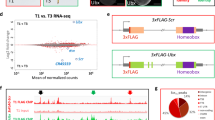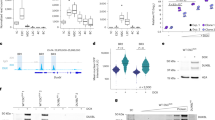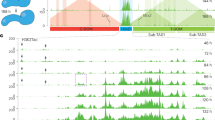Abstract
Low-level ectopic expression of the Runt transcription factor blocks activation of the Drosophila melanogaster segmentation gene engrailed (en) in odd-numbered parasegments and is associated with a lethal phenotype. Here we show, by using a genetic screen for maternal factors that contribute in a dose-dependent fashion to Runt-mediated repression, that there are two distinct steps in the repression of en by Runt. The initial establishment of repression is sensitive to the dosage of the zinc-finger transcription factor Tramtrack. By contrast, the co-repressor proteins Groucho and dCtBP, and the histone deacetylase Rpd3, do not affect establishment but instead maintain repression after the blastoderm stage. The distinction between establishment and maintenance is confirmed by experiments with Runt derivatives that are impaired specifically for either co-repressor interaction or DNA binding. Other transcription factors can also establish repression in Rpd3-deficient embryos, which indicates that the distinction between establishment and maintenance may be a general feature of eukaryotic transcriptional repression.
This is a preview of subscription content, access via your institution
Access options
Subscribe to this journal
Receive 12 print issues and online access
$209.00 per year
only $17.42 per issue
Buy this article
- Purchase on Springer Link
- Instant access to full article PDF
Prices may be subject to local taxes which are calculated during checkout





Similar content being viewed by others
References
Tracey, W.D.J., Ning, X., Klingler, M., Kramer, S.G. & Gergen, J.P. Quantitative analysis of gene function in the Drosophila embryo. Genetics 154, 273–284 (2000).
Aronson, B.D., Fisher, A.L., Blechman, K., Caudy, M. & Gergen, J.P. Groucho-dependent and -independent repression activities of Runt domain proteins. Mol. Cell. Biol. 17, 5581–5587 (1997).
Nibu, Y., Zhang, H. & Levine, M. Interaction of short-range repressors with Drosophila CtBP in the embryo. Science 280, 101–104 (1998).
Phippen, T.M. et al. Drosophila C-terminal binding protein functions as a context-dependent transcriptional co-factor and interferes with both mad and groucho transcriptional repression. J. Biol. Chem. 275, 37628–37637 (2000).
Paroush, Z. et al. Groucho is required for Drosophila neurogenesis, segmentation, and sex determination and interacts directly with hairy-related bHLH proteins. Cell 79, 805–815 (1994).
Fisher, A.L., Ohsako, S. & Caudy, M. The WRPW motif of the hairy-related basic helix-loop-helix repressor proteins acts as a 4-amino-acid transcription repression and protein-protein interaction domain. Mol. Cell. Biol. 16, 2670–2677 (1996).
Mannervik, M. & Levine, M. The Rpd3 histone deacetylase is required for segmentation of the Drosophila embryo. Proc. Natl Acad. Sci. USA 96, 6797–6801 (1999).
De Rubertis, F. et al. The histone deacetylase RPD3 counteracts genomic silencing in Drosophila and yeast. Nature 384, 589–591 (1996).
Read, D. & Manley, J.L. Alternatively spliced transcripts of the Drosophila tramtrack gene encode zinc finger proteins with distinct DNA binding specificities. EMBO J. 11, 1035–1044 (1992).
Read, D., Levine, M. & Manley, J.L. Ectopic expression of the Drosophila tramtrack gene results in multiple embryonic defects including repression of even-skipped and fushi-tarazu. Mech. Dev. 38, 183–196 (1992).
Chou, T.B. & Perrimon, N. The autosomal FLP-DFS technique for generating germline mosaics in Drosophila melanogaster. Genetics 144, 1673–1679 (1996).
Kramer, S.G., Jinks, T.M., Schedl, P. & Gergen, J.P. Direct activation of Sex-lethal transcription by the Drosophila runt protein. Development 126, 191–200 (1999).
Xiong, W.C. & Montell, C. tramtrack is a transcriptional repressor required for cell fate determination in the Drosophila eye. Genes Dev. 7, 1085–1096 (1993).
Giesen, K. et al. Glial development in the Drosophila CNS requires concomitant activation of glial and repression of neuronal differentiation genes. Development 124, 2307–2316 (1997).
Zollman, S., Godt, D., Privé, G.G., Couderc, J. & Laski, F.A. The BTB domain, found primarily in zinc finger proteins, defines an evolutionarily conserved family that includes several developmentally regulated genes in Drosophila. Proc. Natl Acad. Sci. USA 91, 10717–10721 (1994).
Chen, G., Fernandez, J., Mische, S. & Courey, A.J. A functional interaction between the histone deacetylase Rpd3 and the corepressor groucho in Drosophila development. Genes Dev. 13, 2218–2230 (1999).
Ng, H.H. & Bird, A. Histone deacetylases: silencers for hire. Trends Biochem. Sci. 25, 121–126 (2000).
Kania, M.A., Bonner, A.S., Duffy, J.B. & Gergen, J.P. The Drosophila segmentation gene runt encodes a novel nuclear regulatory protein that is also expressed in the developing nervous system. Genes Dev. 4, 1701–1713 (1990).
Brand, A.H. & Perrimon, N. Targeted gene expression as a means of altering cell fates and generating dominant phenotypes. Development 118, 401–415 (1993).
Tsai, C. & Gergen, J.P. Gap gene properties of the pair-rule gene runt during Drosophila segmentation. Development 120, 1671–1683 (1994).
Manoukian, A.S. & Krause, H.M. Concentration-dependent activities of the even-skipped protein in Drosophila embryos. Genes Dev. 6, 1740–1751 (1992).
Riechmann, V., Irion, U., Wilson, R., Grosskortenhaus, R. & Leptin, M. Control of cell fates and segmentation in the Drosophila mesoderm. Development 124, 2915–2922 (1997).
Klingler, M. & Gergen, J.P. Regulation of runt transcription by Drosophila segmentation genes. Mech. Dev. 43, 3–19 (1993).
Acknowledgements
We thank the Drosophila Stock Center in Bloomington and our colleagues who provided Drosophila stocks and plasmid DNAs; S. Kramer and L.-H. Li for the p[UAS–run[CK]] construct and the initial UAS–run[CK] transformant line, respectively; X. Ning for help with generating the UAS–run[Δ8] construct and transformant lines; T. Kalkan for help with characterizing the effects of deficiency chromosomes; and J. Landry and members of the Gergen laboratory for comments on the manuscript. This work was supported by grants from the NIH and the NSF to J.P.G.
Author information
Authors and Affiliations
Corresponding author
Ethics declarations
Competing interests
The authors declare no competing financial interests.
Rights and permissions
About this article
Cite this article
Wheeler, J., VanderZwan, C., Xu, X. et al. Distinct in vivo requirements for establishment versus maintenance of transcriptional repression. Nat Genet 32, 206–210 (2002). https://doi.org/10.1038/ng942
Received:
Accepted:
Published:
Issue Date:
DOI: https://doi.org/10.1038/ng942
This article is cited by
-
RUNX1 contributes to the mesenchymal subtype of glioblastoma in a TGFβ pathway-dependent manner
Cell Death & Disease (2019)
-
The RUNX family: developmental regulators in cancer
Nature Reviews Cancer (2015)
-
Identifying targets of the Sox domain protein Dichaete in the Drosophila CNS via targeted expression of dominant negative proteins
BMC Developmental Biology (2013)
-
Drosophila Ebi mediates Snail-dependent transcriptional repression through HDAC3-induced histone deacetylation
The EMBO Journal (2008)
-
Filtering transcriptional noise during development: concepts and mechanisms
Nature Reviews Genetics (2006)



